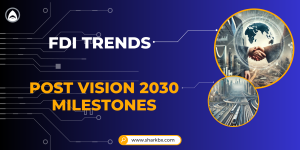FDI Trends in Saudi Infrastructure Post Vision 2030 Milestones

The transformative agenda of Saudi Arabia’s Vision 2030 has placed infrastructure development at the core of its economic diversification strategy. As the Kingdom marks significant milestones in its journey, foreign direct investment (FDI) is emerging as a key enabler in building the future. This article explores the evolving trends in FDI within Saudi infrastructure, delving into their implications for the nation’s economy, business landscape, and global standing.
FDI in Infrastructure: A Strategic Imperative
Infrastructure has been a cornerstone of Saudi Arabia’s Vision 2030, driving investments in transportation, energy, urban development, and digital connectivity. The focus on modernizing infrastructure has made the Kingdom an attractive destination for global investors.
Key Areas of Investment
- Transport and Logistics: Projects such as the Riyadh Metro, NEOM’s The Line, and the Red Sea International Airport showcase the Kingdom’s commitment to enhancing connectivity. These initiatives aim to position Saudi Arabia as a global logistics hub.
- Renewable Energy: With a target of generating 50% of its energy from renewables by 2030, Saudi Arabia’s investments in solar and wind projects, such as the Sakaka Solar Power Plant and Dumat Al Jandal Wind Farm, have attracted significant FDI. According to recent figures, renewable energy projects alone are expected to draw over $50 billion in investments.
- Urban Development: The establishment of giga-projects like Qiddiya, King Salman Park, and Diriyah Gate demonstrates the Kingdom’s focus on creating sustainable urban environments that cater to residents and tourists alike. Investments in these projects have the potential to add over $150 billion to Saudi Arabia’s economy.
- Digital Transformation: Investments in 5G networks, smart city initiatives, and technology hubs underline Saudi Arabia’s ambition to lead in the digital economy. The launch of the National Strategy for Data and AI is expected to contribute $135 billion to the GDP by 2030.
Trends Shaping FDI in Saudi Infrastructure
- Increased Public-Private Partnerships (PPPs) The Saudi government has adopted PPPs as a mechanism to attract FDI, leveraging private sector expertise and capital to deliver large-scale projects. Initiatives such as the privatization of airports and water desalination plants highlight the success of this approach.
- Diversification of Investment Sources While traditional investors from Europe and the United States remain prominent, Saudi Arabia has witnessed growing interest from Asian markets, particularly China, India, and South Korea. The Chinese Belt and Road Initiative aligns well with Saudi Arabia’s infrastructure ambitions, fostering stronger economic ties and technology transfer.
- Green Financing and ESG-Driven Investments Sustainability is a critical aspect of Vision 2030, with the Kingdom prioritizing projects that align with environmental, social, and governance (ESG) criteria. Green bonds and climate-conscious funds are increasingly driving FDI flows into renewable energy and sustainable urban development. Saudi Arabia’s Green Saudi Initiative and the Green Middle East Initiative have solidified its role as a regional leader in sustainability.
- Regulatory Reforms and Business Incentives The Saudi government has introduced reforms to enhance the ease of doing business, such as streamlining licensing procedures, increasing transparency, and offering tax incentives for foreign investors. These measures, along with the National Investment Strategy, have successfully attracted inflows of FDI across diverse sectors.
Saudi Arabia’s FDI inflows reached $10.5 billion in Q1 2024, positioning the Kingdom among the top G20 nations for investment attractiveness.
H.E. Eng. Khalid Al-Falih, Saudi Arabia’s Minister of Investment, stated during a recent investment forum:
“Saudi Arabia’s open economy, strategic reforms, and world-class projects provide unmatched opportunities for investors globally. Vision 2030 is transforming the Kingdom into a hub for innovation and economic progress.”
Economic Impact of FDI in Infrastructure
- GDP Growth and Job Creation FDI in infrastructure is a significant driver of GDP growth, contributing to construction, technology, and service sectors. According to recent projections, infrastructure-related FDI will contribute 2.5% to 3% of Saudi Arabia’s annual GDP growth. These investments have also generated thousands of jobs for Saudi nationals, aligning with Saudization goals and fostering youth employment.
- Enhancing Competitiveness Modern infrastructure strengthens Saudi Arabia’s global competitiveness, attracting multinational corporations and enabling the Kingdom to serve as a gateway to regional markets. The logistics sector alone is projected to grow by 12% annually, further cementing the Kingdom’s strategic position.
- Long-Term Fiscal Benefits By fostering private sector participation, FDI reduces the fiscal burden on the government and ensures sustainable funding for future projects.
Challenges and Opportunities
Challenges:
- Regulatory Consistency: While reforms have been transformative, ensuring consistency and transparency remains essential.
- Market Competition: The global race for infrastructure investment means Saudi Arabia must continually enhance its value proposition.
- Sustainability Balancing Act: Aligning rapid development with environmental sustainability presents an ongoing challenge.
Opportunities:
- Digital Innovation: The integration of AI and IoT in infrastructure projects offers opportunities for cutting-edge solutions.
- Regional Collaboration: Cross-border projects, such as the GCC Railway, position Saudi Arabia as a leader in regional infrastructure development.
SharkBX’s Insight: Navigating the Investment Landscape
Saudi Arabia’s infrastructure revolution presents unparalleled opportunities for global investors. As businesses look to participate in the Kingdom’s growth story, navigating the complexities of regulatory frameworks, market dynamics, and strategic alignment is crucial. SharkBX, with its deep expertise in business establishment and growth strategy, is uniquely positioned to support investors entering the Saudi market.
SharkBX can assist businesses through:
- End-to-End Company Setup: From regulatory compliance to operational launch.
- Strategic Advisory: Aligning investor goals with Vision 2030 opportunities.
- Market Integration: Offering seamless entry and expansion strategies.
A Legacy for Vision 2030
As Saudi Arabia continues to advance its Vision 2030 goals, the role of FDI in shaping the nation’s infrastructure landscape is undeniable. These investments are not just building roads and cities; they are constructing a future that positions the Kingdom as a global economic powerhouse.
For investors, the opportunities are vast, and the timing is perfect. Companies like SharkBX are ready to help businesses navigate this transformative journey and contribute to Saudi Arabia’s success story.
